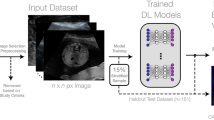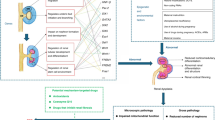Abstract
Background
The objective of our study was to examine the risk for submicroscopic chromosomal aberrations among fetuses with apparently isolated solitary kidney.
Methods
Data acquisition was performed retrospectively by searching Israeli Ministry of Health-computerized database. All cases having chromosomal microarray analysis (CMA), referred because of an indication of isolated unilateral kidney agenesis between January 2013 and September 2016, were included. Rate of clinically significant CMA findings in these pregnancies was compared to pregnancies with normal ultrasound, based on a systematic review encompassing 9,792 cases and local data of 5,541 pregnancies undergoing CMA because of maternal request.
Results
Of the 81 pregnancies with isolated solitary kidney, 2 (2.47%) loss-of-copy number variants compatible with well-described deletion syndromes were reported (16p11.2–16p12.2 and 22q11.21 microdeletion syndromes). In addition, one variant of unknown significance was demonstrated. The relative risk for pathogenic CMA findings among pregnancies with isolated unilateral renal agenesis was not significantly different compared with the control population.
Conclusion
CMA analysis in pregnancies with unilateral renal agenesis might still be useful, to the same degree as it can be in the general population.
Similar content being viewed by others
Log in or create a free account to read this content
Gain free access to this article, as well as selected content from this journal and more on nature.com
or
References
Natarajan G, Jeyachandran D, Subramaniyan B et al. Congenital anomalies of kidney and hand: a review. Clin Kidney J 2013;6:144–9.
Yosypiv IV . Congenital anomalies of the kidney and urinary tract: a genetic disorder? Int J Nephrol 2012;2012:909083.
Woolf AS, Hillman KA . Unilateral renal agenesis and the congenital solitary functioning kidney: developmental, genetic and clinical perspectives. BJU Int 2007;99:17–21.
Chow JS, Benson CB, Lebowitz RL . The clinical significance of an empty renal fossa on prenatal sonography. J Ultrasound Med 2005;24:1049–54 quiz 55-7.
Mesrobian HG, Rushton HG, Bulas D . Unilateral renal agenesis may result from in utero regression of multicystic renal dysplasia. J Urol 1993;150 (2 Pt 2): 793–4.
Cascio S, Paran S, Puri P . Associated urological anomalies in children with unilateral renal agenesis. J Urol 1999;162 (3 Pt 2): 1081–3.
Capone VP, Morello W, Taroni F et al. Genetics of congenital anomalies of the kidney and urinary tract: the current state of play. Int J Mol Sci 2017;18:4.
Uy N, Reidy K . Developmental genetics and congenital anomalies of the kidney and urinary tract. J PediatrGenet 2016;5:51–60.
Pallotta R, Bucci I, Celentano C et al. The 'skipped generation' phenomenon in a family with renal agenesis. Ultrasound Obstetr Gynecol 2004;24:586–7.
Nicolaides KH, Cheng HH, Abbas A et al. Fetal renal defects: associated malformations and chromosomal defects. Fetal Diagn Ther 1992;7:1–11.
Westland R, Verbitsky M, Vukojevic K et al. Copy number variation analysis identifies novel CAKUT candidate genes in children with a solitary functioning kidney. Kidney Int 2015;88:1402–10.
Kearney HM, Thorland EC, Brown KK et al. Working Group of the American College of Medical Genetics Laboratory Quality Assurance C. American College of Medical Genetics standards and guidelines for interpretation and reporting of postnatal constitutional copy number variants. Genet Med 2011;13:680–5.
South ST, Lee C, Lamb AN et al. ACMG Standards and Guidelines for constitutional cytogenomic microarray analysis, including postnatal and prenatal applications: revision 2013. Genet Med 2013;15:901–9.
Callaway JL, Shaffer LG, Chitty LS et al. The clinical utility of microarray technologies applied to prenatal cytogenetics in the presence of a normal conventional karyotype: a review of the literature. Prenatal Diagn 2013;33:1119–23.
Barber JC, Hall V, Maloney VK et al. 16p11.2-p12.2 duplication syndrome; a genomic condition differentiated from euchromatic variation of 16p11.2. Eur J Hum Genet 2013;21:182–9.
Hernando C, Plaja A, Rigola MA et al. Comparative genomic hybridisation shows a partial de novo deletion 16p11.2 in a neonate with multiple congenital malformations. J Med Genet 2002;39:E24.
Okamoto N, Fujii T, Tanaka J et al. A clinical study of patients with pericentromeric deletion and duplication within 16p12.2-p11.2. Am J Med Genet Part A 2014;164A:213–9.
McDonald-McGinn DM EB, Zackai EH. 22q11.2 deletion syndrome. In: Pagon RA, Adam MP, Ardinger HH, et al., eds. GeneReviews®. Seatle, WA: University of Washington, Seattle. 1999:1993–2017.
Grati FR, Molina Gomes D, Ferreira JC et al. Prevalence of recurrent pathogenic microdeletions and microduplications in over 9500 pregnancies. Prenatal Diagn 2015;35:801–9.
McDonald-McGinn DM, Sullivan KE, Marino B et al. 22q11.2 deletion syndrome. Nat Rev Dis Primers 2015;1:15071.
Stewart TL, Irons MB, Cowan JM et al. Increased incidence of renal anomalies in patients with chromosome 22q11 microdeletion. Teratology 1999;59:20–2.
Besseau-Ayasse J, Violle-Poirsier C, Bazin A et al. A French collaborative survey of 272 fetuses with 22q11.2 deletion: ultrasound findings, fetal autopsies and pregnancy outcomes. Prenatal Diagn 2014;34:424–30.
Wu HY, Rusnack SL, Bellah RD et al. Genitourinary malformations in chromosome 22q11.2 deletion. J Urol 2002;168:2564–5.
Hillman SC, Pretlove S, Coomarasamy A et al. Additional information from array comparative genomic hybridization technology over conventional karyotyping in prenatal diagnosis: a systematic review and meta-analysis. Ultrasound Obstetr Gynecol 2011;37:6–14.
Acknowledgements
We are grateful to all Israeli genetic counselors and laboratory workers engaged in prenatal evaluation of fetal malformations, who made this study possible.
Author information
Authors and Affiliations
Corresponding author
Ethics declarations
Competing interests
The authors declare no conflict of interest.
Rights and permissions
About this article
Cite this article
Sagi-Dain, L., Maya, I., Peleg, A. et al. Microarray analysis in pregnancies with isolated unilateral kidney agenesis. Pediatr Res 83, 825–828 (2018). https://doi.org/10.1038/pr.2018.3
Received:
Revised:
Accepted:
Published:
Issue date:
DOI: https://doi.org/10.1038/pr.2018.3
This article is cited by
-
Is an analysis of copy number variants necessary for various types of kidney ultrasound anomalies in fetuses?
Molecular Cytogenetics (2019)
-
Congenital Anomalies of the Kidney and Urinary Tract: a Clinical Review
Current Treatment Options in Pediatrics (2019)



